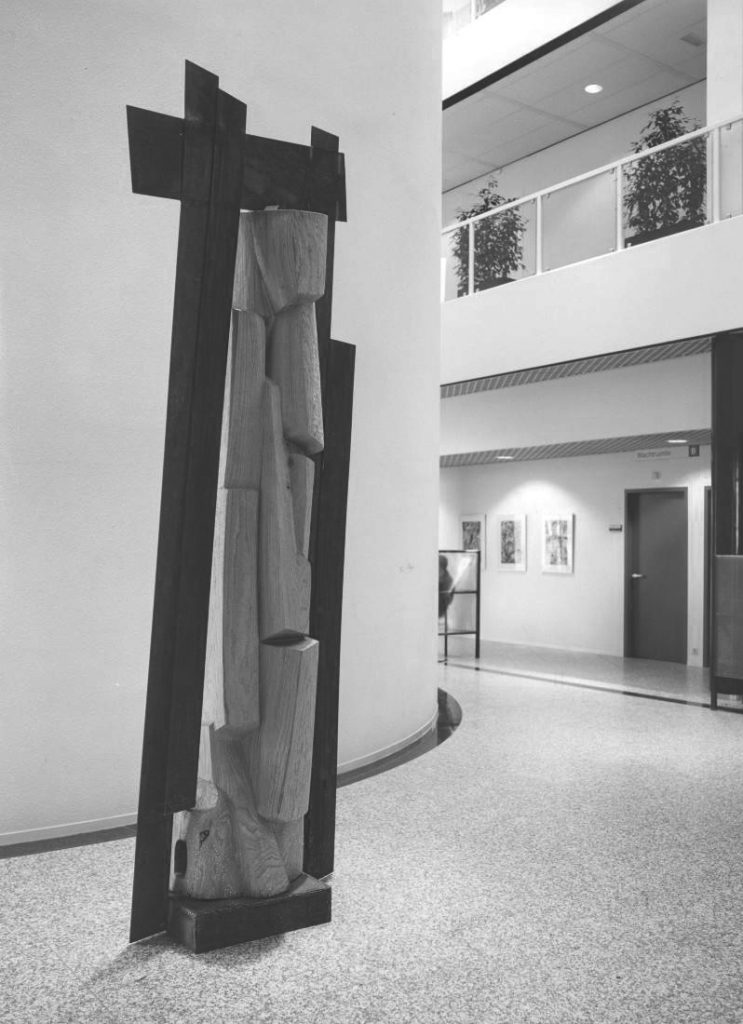My sculptural work is my real curriculum. Without words in the normal sense, it records time-space experiences, experiences involving union with nature and the materials the sculpture comprises. Environmental consciousness is translated forcefully into care and human dimension.
Things/objects become signs of mental growth and religious union. It is an attempt to return to space its wholeness. Whenever I do put words on my sculptures, it is to facilitate the auditive nature of what we see. But as far as I am concerned, verbal reality is secondary.

Assumptions pertaining to a sculpture.
Questions about assumptions are intellectual in nature: they ask, What does it mean?’ This type of question is one artists frequently face these days, and understandably so. But I would still like to ask it to a random employee at a random company, about his or her daily activities. My assumption is that many people would grope for words. The question is not simple. Why are you in this job, and what does your work mean?’ My answer is persistent: I can’t do otherwise, and I like it!’ Many people see beauty in what I make, and it confuses others. But that is the same effect I frequently observe in office work.
To understand modern art, many people look for clues in the title: we are language-oriented people. This has prompted the explanation below of the title of this article. It is my reply to the question.
Sophia is wisdom in Greek, the wisdom of Western thought. It affects each of us. Reflection on my work over the past few years has thrust on me the conclusion that the wood and iron I manipulated were always in contrast to one another, two elements which complemented each other or started a dialogue. I wondered whether it might be possible to align these two materials; whether the iron could blend naturally into the wood. For me, iron represents predominantly masculine, reflective properties: not surprisingly, it was the first metal contrived by man. By contrast, wood, and especially elm wood, impresses me as something affective and feminine. In the Germanic mythological book the Edda, the Embla (elm) is the initial mother of creation. The mathematical shapes which make up this sculpture symbolize this quest for and reflection upon dimensions and proportion. It is an analysis of the materials applied to construct it.
And that is not the end. An entirely different process was completed in the course of making this sculpture. The sculpture was the catalyst for several artists from various disciplines to begin a quest to make my (the sculptor’s) artistic process, which remains largely invisible in my studio, accessible for a larger audience. In the final analysis, sculptures are simply occasionally frozen moments in a continuous, creative process. Expressing yourself to a fellow professional from another discipline is a real experience, and requires transparency, or, to use the composer’s term, listening skills. As a sculptor works with dimensions, proportion, space and his hands, a composer crafts time, sound and melody with his ears. A sculptor works alone while a musician writes for performers. By entering a relationship, the creative process accelerated rapidly for all those involved. This sculpture, Sophia, should really be part of a theatrical piece now being prepared under my leadership. Like the totem poles erected by the ancient tribes, it would be the axis around which the rite, comprising music, song and dance, is performed. In ‘primitive’ tribes, the totem pole is erected for a ritual. It often represents an ancestor. And that brings me to the rest of my title: ‘alias Fieke’. Fieke is a Dutch girl’s name derived from Sophia. It is also the name of my mother, who died in my infancy. Rilke is entirely correct in stating that the creative process is derived from the fear of death. My confrontation with death at such an early age prompted me to study theology and be active in sculpting, retaining the sculpture…, creating space… This sculpture (really every sculpture I make) is the achievement of entities, realities from my life which are not immediately observable and which are situated in the mental realm. Knowledge of this world is often neglected in the West (e.g., our attempts to ward off death). But by positioning this concretely in space, we can no longer avoid this fact. Music may waft away with the wind, a wild dance is extinguished in exhaustion, but sculptures define space.